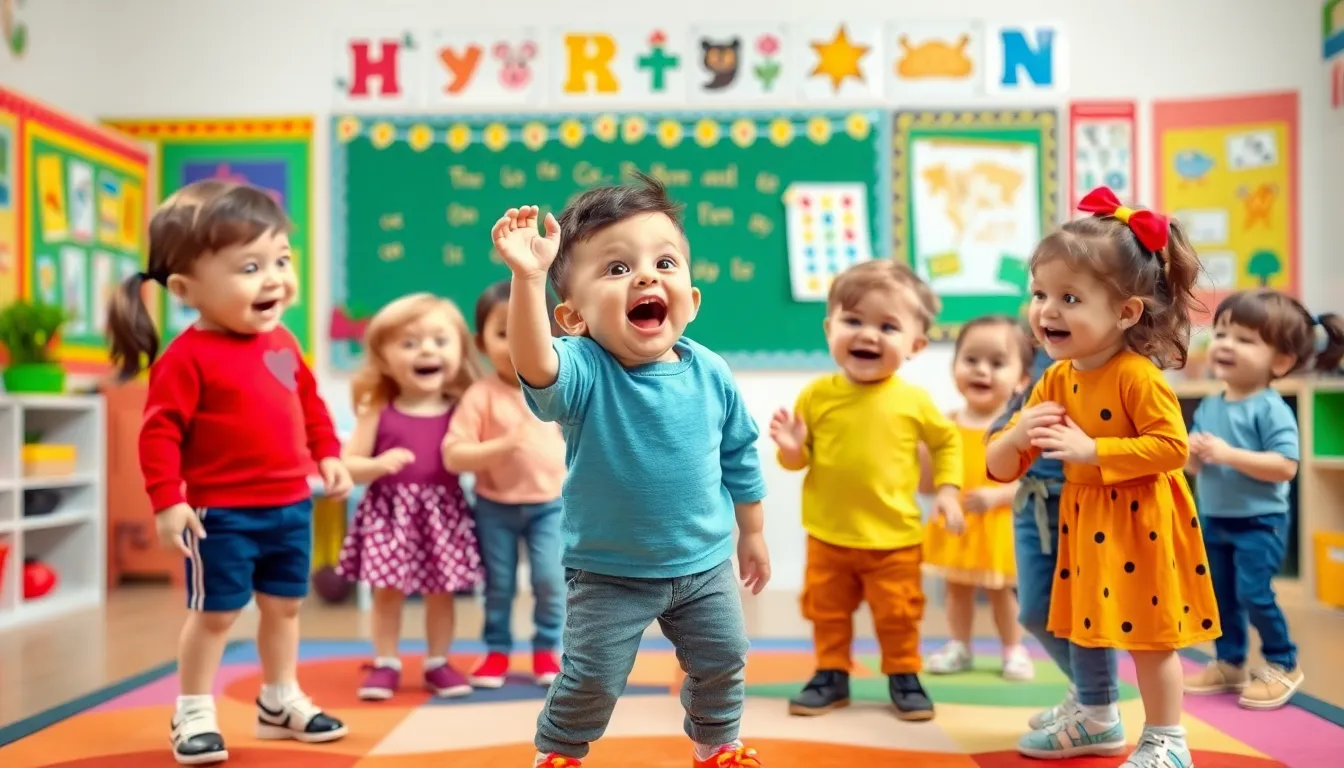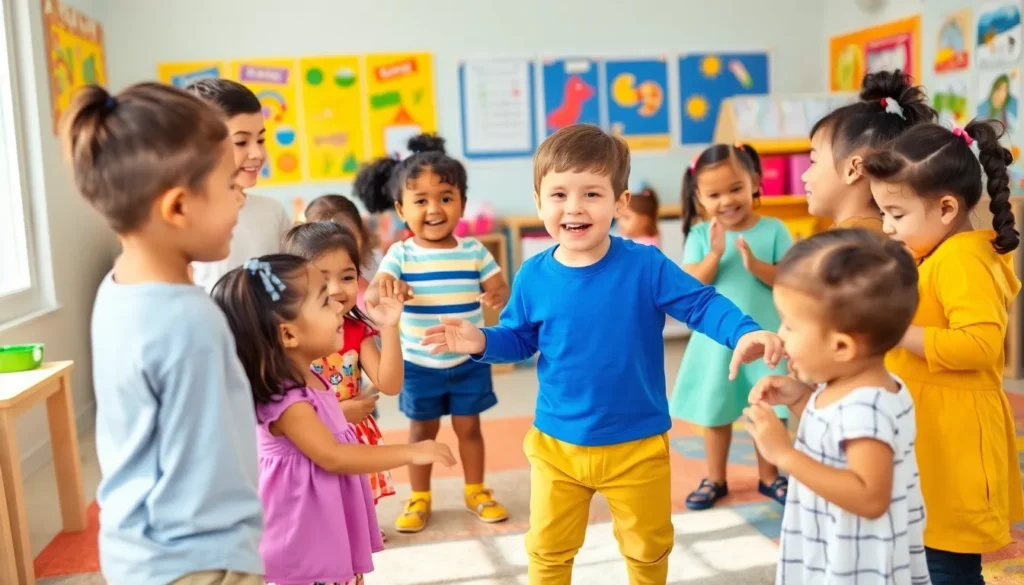Table of Contents
ToggleWhen it comes to preschoolers, nothing captures their attention quite like a catchy tune. Rhyming songs are not just fun—they’re a secret weapon for sparking creativity and boosting language skills. Imagine a world where kids giggle and dance while effortlessly learning new words. Sounds magical, right?
Importance Of Rhyming Songs For Preschoolers
Rhyming songs play a vital role in preschoolers’ development. These tunes make learning engaging while fostering essential skills.
Enhancing Language Skills
Exposure to rhymes improves vocabulary and pronunciation. Children enjoy repeating phrases, which solidifies their understanding of language patterns. Songs like “Twinkle, Twinkle, Little Star” introduce new words in a fun way. As preschoolers sing, they practice articulation and rhythm, making speech clearer. Rhyming also makes memorization easier, helping young learners recall words effortlessly. Engaging with lyrics encourages conversation and language exploration, setting a foundation for effective communication.
Boosting Cognitive Development
Cognitive skills benefit significantly from the rhythmic structure of songs. Rhymes create predictable patterns, enhancing memory and recall abilities. Preschoolers develop critical thinking as they connect meanings to words and phrases. Songs often incorporate counting or categorization, introducing early math concepts. Singing aids in pattern recognition, important for problem-solving skills. Rhyming activities stimulate creativity, allowing children to express themselves freely. Through music and rhythm, preschoolers build a stronger cognitive base for future learning.
Popular Rhyming Songs For Preschoolers

Rhyming songs play a vital role in preschoolers’ language development. Here are some popular examples that preschoolers love.
Classic Nursery Rhymes
Classic nursery rhymes stand the test of time. “Humpty Dumpty” teaches about rhythm and offers memorable lines that children enjoy repeating. “Baa, Baa, Black Sheep” introduces simple vocabulary while engaging kids with its catchy melody. “Jack and Jill” presents a narrative that children can visualize, enhancing comprehension skills. Rhymes like “Hickory Dickory Dock” emphasize repetition, making it easy for preschoolers to recall phrases. Each of these songs supports language acquisition through fun and interactive experiences.
Contemporary Rhymes
Contemporary rhymes captivate young audiences with modern twists. “The Wheels on the Bus” encourages movement, inviting children to act out lines while singing along. “Baby Shark” captures attention with its repetitive structure and infectious beat. “If You’re Happy and You Know It” promotes emotional recognition through actions that match the lyrics. These songs foster social interaction as children sing together and collaborate on movements. Engaging with contemporary rhymes provides both entertainment and educational benefits that align with preschool curricula.
Activities To Incorporate Rhyming Songs
Engaging preschoolers with rhyming songs promotes their language development through interactive activities. Incorporating these activities enhances the joy of learning.
Sing-Along Sessions
Sing-along sessions invite preschoolers to join in. Choose popular rhyming songs like “Twinkle, Twinkle, Little Star.” Encourage children to sing together, fostering group participation. As they sing, emphasize the rhythmic patterns. This approach helps improve pronunciation and vocabulary retention. Repeating lines during the session allows children to remember words easily. Adjust the pace to match the children’s comfort level, making it fun and inclusive. Frequent sing-along sessions create a lively atmosphere that reinforces language patterns through music.
Interactive Games
Interactive games amplify the learning experience. Create a matching game using images that correspond to song lyrics. For instance, pair pictures of “The Wheels on the Bus” with actions. Children identify characters or scenes while singing, fostering comprehension skills. Implement a follow-the-leader element by incorporating dance moves with songs. This action-oriented approach reinforces memory through physical activity. Rhyming scavenger hunts also engage preschoolers and enhance recognition of rhyming words. Using games introduces playful learning while building essential language skills.
Tips For Teaching Rhyming Songs
Teaching rhyming songs can create an enjoyable learning atmosphere for preschoolers. Incorporating various techniques encourages engagement and retention in young learners.
Engaging Parents and Caregivers
Involve parents and caregivers in the learning process to enhance the impact of rhyming songs. Organize sing-along sessions where these adults can participate and model enthusiasm. Encourage caregivers to sing at home, reinforcing the songs’ rhythms and patterns. Sharing lyrics enables families to easily remember and teach songs together. Provide resources such as playlists to keep parents informed about popular rhymes. Create a welcoming environment that supports collaboration in learning, which significantly boosts children’s language skills.
Using Visual Aids
Utilizing visual aids can significantly boost children’s understanding of rhyming songs. Display colorful images and illustrations that correlate with lyrics, allowing kids to make visual connections. Flashcards featuring key words from the songs help preschoolers recognize and remember vocabulary. Incorporate props that relate to specific lyrics, promoting interactive learning opportunities. Use movement-based activities to align visuals with the rhythm. Engaging multiple senses enhances retention, deepening comprehension while keeping learning fun and dynamic.
Rhyming songs offer a delightful way for preschoolers to learn and grow. They not only make language acquisition enjoyable but also foster creativity and cognitive development. By incorporating these catchy tunes into daily routines, children can enhance their vocabulary and pronunciation while having fun.
Engaging parents and caregivers in this musical journey strengthens the learning experience at home. With a mix of classic and contemporary rhymes, preschoolers can explore language in a dynamic way. The rhythm and repetition found in these songs create a solid foundation for future learning, ensuring that children develop essential skills while enjoying the magic of music.







